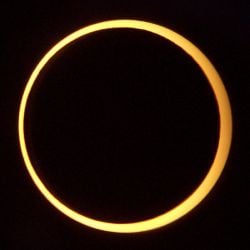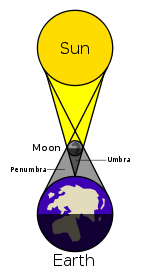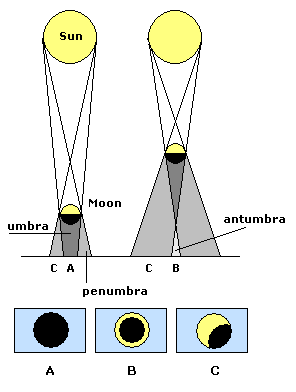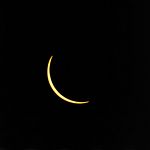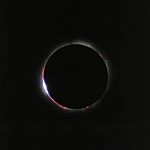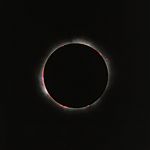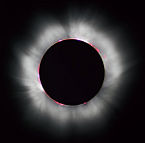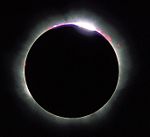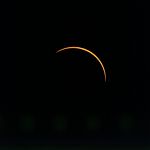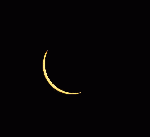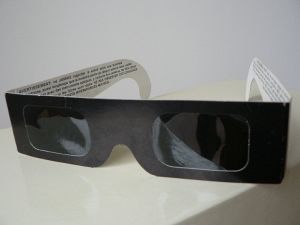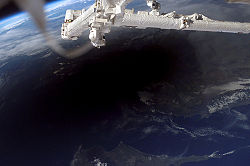Solar eclipse
A solar eclipse occurs when the Moon passes between Earth and the Sun, thereby totally or partially obscuring Earth's view of the Sun. This configuration can only occur during a new moon, when the Sun and Moon are in conjunction as seen from the Earth. In ancient times, and in some cultures today, solar eclipses are attributed mythical properties, thus influencing human civilization. Total solar eclipses can be frightening events for people unaware of their astronomical nature, as the Sun suddenly disappears in the middle of the day and the sky darkens in a matter of minutes. However, the spiritual attribution of solar eclipses is now largely disregarded. Total solar eclipses are very rare events for any given place on Earth because totality is only seen where the Moon's umbra touches the Earth's surface. A total solar eclipse is a spectacular natural phenomenon and many people travel to remote locations in order to observe one.
Types
There are four types of solar eclipse:
- A total eclipse occurs when the Sun is completely obscured by the Moon. The intensely bright disk of the Sun is replaced by the dark outline of the Moon, and the much fainter corona is visible. During any one eclipse, totality is visible only from at most a narrow track on the surface of the Earth.
- An annular eclipse occurs when the Sun and Moon are exactly in line, but the apparent size of the Moon is smaller than that of the Sun. Hence the Sun appears as a very bright ring, or annulus, surrounding the outline of the Moon.
- A hybrid eclipse is intermediate between a total and annular eclipse. At some points on the surface of the Earth it is visible as a total eclipse, whereas at others it is annular. Hybrid eclipses are rather rare.
- A partial eclipse occurs when the Sun and Moon are not exactly in line, and the Moon only partially obscures the Sun. This phenomenon can usually be seen from a large part of the Earth outside of the track of an annular or total eclipse. However, some eclipses can only be seen as a partial eclipse, because the umbra never intersects the Earth's surface.
The Earth's distance from the Sun is about 400 times the Moon's distance from the Earth. The Sun's diameter is about 400 times the diameter of the Moon. Because these ratios are approximately the same, the sizes of the Sun and the Moon as seen from Earth appear to be approximately the same: About 0.5 degree of arc in angular measure.
Because the Moon's orbit around the Earth is an ellipse, as is the Earth's orbit around the Sun, the apparent sizes of the Sun and Moon vary.[1] The magnitude of an eclipse is the ratio of the apparent size of the Moon to the apparent size of the Sun during an eclipse. An eclipse when the Moon is near its closest distance from the Earth (that is, near its perigee) can be a total eclipse because the Moon will appear to be large enough to cover completely the Sun's bright disk, or photosphere; a total eclipse has a magnitude greater than 1. Conversely, an eclipse when the Moon is near its farthest distance from the Earth (near its apogee) can only be an annular eclipse because the Moon will appear to be slightly smaller than the Sun; the magnitude of an annular eclipse is less than 1. Slightly more solar eclipses are annular than total because, on average, the Moon lies too far from Earth to cover the Sun completely. A hybrid eclipse occurs when the magnitude of an eclipse is very close to 1: the eclipse will appear to be total at some locations on Earth and annular at other locations.[2]
The Earth's orbit around the Sun is also elliptical, so the Earth's distance from the Sun varies throughout the year. This also affects the apparent sizes of the Sun and Moon, but not so much as the Moon's varying distance from the Earth. When the Earth approaches its farthest distance from the Sun (the aphelion) in July, this tends to favor a total eclipse. As the Earth approaches its closest distance from the Sun (the perihelion) in January, this tends to favor an annular eclipse.
Terminology
Central eclipse is often used as a generic term for a total, annular, or hybrid eclipse. This is, however, not completely correct: The definition of a central eclipse is an eclipse during which the central line of the umbra touches the Earth's surface. It is possible, though extremely rare, that part of the umbra intersects with Earth (thus creating an annular or total eclipse), but not its central line. This is then called a non-central total or annular eclipse.[3]
The term solar eclipse itself is strictly speaking a misnomer. The phenomenon of the Moon passing in front of the Sun is not an eclipse, but an occultation. Properly speaking, an eclipse occurs when one object passes into the shadow cast by another object. For example, when the Moon disappears at full moon by passing into Earth's shadow, the event is properly called a lunar eclipse. Therefore, technically, a solar eclipse actually amounts to an eclipse of the Earth.
Predictions
Geometry
The diagram to the right shows the alignment of the Sun, Moon, and Earth during a solar eclipse. The dark gray region below the Moon is the umbra, where the Sun is completely obscured by the Moon. The small area where the umbra touches the Earth's surface is where a total eclipse can be seen. The larger light gray area is the penumbra, in which only a partial eclipse can be seen.
The Moon's orbit around the Earth is inclined at an angle of just over 5 degrees to the plane of the Earth's orbit around the Sun (the ecliptic). Because of this, at the time of a new moon, the Moon will usually pass above or below the Sun. A solar eclipse can occur only when the new moon occurs close to one of the points (known as nodes) where the Moon's orbit crosses the ecliptic.
As noted above, the Moon's orbit is also elliptical. The Moon's distance from the Earth can vary by about 6 percent from its average value. Therefore, the Moon's apparent size varies with its distance from the Earth, and it is this effect that leads to the difference between total and annular eclipses. The distance of the Earth from the Sun also varies during the year, but this is a smaller effect. On average, the Moon appears to be slightly smaller than the Sun, so the majority (about 60 percent) of central eclipses are annular. It is only when the Moon is closer to the Earth than average (near its perigee) that a total eclipse occurs.[4]
The Moon orbits the Earth in approximately 27.3 days, relative to a fixed frame of reference. This is known as the sidereal month. However, during one sidereal month, the Earth has revolved part way around the Sun, making the average time between one new moon and the next longer than the sidereal month: It is approximately 29.5 days. This is known as the synodic month, and corresponds to what is commonly called the lunar month.
The Moon crosses from south to north of the ecliptic at its ascending node, and vice versa at its descending node. However, the nodes of the Moon's orbit are gradually moving in a retrograde motion, due to the action of the Sun's gravity on the Moon's motion, and they make a complete circuit every 18.6 years. This means that the time between each passage of the Moon through the ascending node is slightly shorter than the sidereal month. This period is called the draconic month.
Finally, the Moon's perigee is moving forwards in its orbit, and makes a complete circuit in about 9 years. The time between one perigee and the next is known as the anomalistic month.
The Moon's orbit intersects with the ecliptic at the two nodes that are 180 degrees apart. Therefore, the new moon occurs close to the nodes at two periods of the year approximately six months apart, and there will always be at least one solar eclipse during these periods. Sometimes the new moon occurs close enough to a node during two consecutive months. This means that in any given year, there will always be at least two solar eclipses, and there can be as many as five. However, some are visible only as partial eclipses, because the umbra passes above Earth's north or south pole, and others are central only in remote regions of the Arctic or Antarctic.[5]
Path
During a central eclipse, the Moon's umbra (or antumbra, in the case of an annular eclipse) moves rapidly from west to east across the Earth. The Earth is also rotating from west to east, but the umbra always moves faster than any given point on the Earth's surface, so it almost always appears to move in a roughly west-east direction across a map of the Earth (there are some rare exceptions to this which can occur during an eclipse of the midnight sun in Arctic or Antarctic regions).
The width of the track of a central eclipse varies according to the relative apparent diameters of the sun and moon. In the most favorable circumstances, when a total eclipse occurs very close to perigee, the track can be over 250 km wide and the duration of totality may be over 7 minutes. Outside of the central track, a partial eclipse can usually be seen over a much larger area of the Earth.
Occurrence and cycles
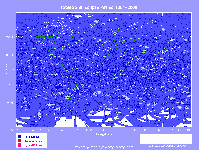
Total solar eclipses are rare events. Although they occur somewhere on Earth approximately every 18 months, it has been estimated that they recur at any given place only once every 370 years, on average. The total eclipse only lasts for a few minutes at that location, as the Moon's umbra moves eastward at over 1700 km/h. Totality can never last more than 7 min 40 s, and is usually much shorter: During each millennium there are typically fewer than 10 total solar eclipses exceeding 7 minutes. The last time this happened was June 30, 1973. Observers aboard a Concorde aircraft were able to stretch totality to about 74 minutes by flying along the path of the Moon's umbra. The next eclipse of comparable duration will not occur until June 25, 2150. The longest total solar eclipse during the 8,000 year period from 3000 B.C.E. to 5000 C.E. will occur on July 16, 2186, when totality will last 7 min 29 s.[7]
If the date and time of any solar eclipse are known, it is possible to predict other eclipses using eclipse cycles. Two such cycles are the Saros and the Inex. The Saros cycle is probably the best known, and one of the most accurate, eclipse cycles. The Inex cycle is itself a poor cycle, but it is very convenient in the classification of eclipse cycles. After a Saros cycle finishes, a new Saros cycle begins one Inex later, hence its name: In-ex. A Saros cycle lasts 6,585.3 days (a little over 18 years), which means that after this period, a practically identical eclipse will occur. The most notable difference will be a shift of 120° in longitude (due to the 0.3 days) and a little in latitude. A Saros series always starts with a partial eclipse near one of Earth's polar regions, then shifts over the globe through a series of annular or total eclipses, and ends at the opposite polar region. A Saros lasts 1226 to 1550 years and 69 to 87 eclipses, with about 40 to 60 central.[8]
Final totality
Due to tidal acceleration, the orbit of the moon around the Earth becomes approximately 3.8 cm more distant each year. It is estimated that in 600 million years, the distance from the Earth to the Moon will have increased by 23,500 km, meaning that it will no longer be able to completely cover the Sun's disk. This will be true even when the Moon is at perigee, and the Earth at aphelion.
A complicating factor is that the sun will increase in size over this timescale. This makes it even more unlikely that the Moon will be able to cause a total eclipse. One can, therefore, say that the last total solar eclipse on Earth will occur in slightly less than 600 million years.[9]
Historical eclipses
A solar eclipse of June 15, 763 B.C.E., mentioned in an Assyrian text is important for the Chronology of the Ancient Orient. Also known as the eclipse of Bur Sagale, it is the earliest solar eclipse mentioned in historical sources that has been successfully identified. Perhaps the earliest still-unproven claim is that of archaeologist Bruce Masse; on the basis of several ancient flood myths that mention a total solar eclipse, he links an eclipse that occurred May 10, 2807 B.C.E., with a possible meteor impact in the Indian Ocean.[10] There have been other claims to date earlier eclipses, notably that of Mursili II (likely 1312 B.C.E.), in Babylonia, and also in China, during the 5th year (2084 B.C.E.) of the regime of king Zhong Kang of Xia dynasty, but these are highly disputed and rely on much supposition.[11]
Herodotus wrote that Thales of Miletus predicted an eclipse which occurred during a war between the Medians and the Lydians. Soldiers on both sides put down their weapons and declared peace as a result of the eclipse. Exactly which eclipse was involved has remained uncertain, although the issue has been studied by hundreds of ancient and modern authorities. One likely candidate took place on May 28, 585 B.C.E., probably near the Halys river in the middle of modern Turkey.[12]
An annular eclipse of the Sun occurred at Sardis on February 17, 478 B.C.E., while Xerxes was departing for his expedition against Greece, as Herodotus recorded.[13] Hind and Chambers considered this absolute date more than a century ago.[14] Herodotus also reports that another solar eclipse was observed in Sparta during the next year, on August 1, 477 B.C.E.[15] The sky suddenly darkened in the middle of the day, well after the battles of Thermopylae and Salamis, after the departure of Mardonius to Thessaly at the beginning of the spring (of 477 B.C.E.) and his second attack on Athens, after the return of Cleombrotus to Sparta. Note that the modern conventional dates are different by a year or two, and that these two eclipse records have been ignored so far.[16] The Chronicle of Ireland recorded a solar eclipse on June 29, 512 C.E., and a solar eclipse was reported to have taken place during the Battle of Stiklestad in the summer of 1030.
It has also been attempted to establish the exact date of Good Friday by means of solar eclipses, but this research has not yielded conclusive results.[17] Research has manifested the inability of total solar eclipses to serve as explanations for the recorded Good Friday features of the crucifixion eclipse.[18]
The ancient Chinese astronomer Shi Shen (fl. fourth century B.C.E.) was aware of the relation of the moon in a solar eclipse, as he provided instructions in his writing to predict them by using the relative positions of the Moon and Sun.[19] The "radiating influence" theory for a solar eclipse (i.e., the Moon's light was merely light reflected from the Sun) was existent in Chinese thought from about the sixth century B.C.E. (in the Zhi Ran of Zhi Ni Zi), and opposed by the Chinese philosopher Wang Chong (27–97 C.E.), who made clear in his writing that this theory was nothing new. This can be said of Jing Fang's writing in the first century B.C.E., which stated:
The moon and the planets are Yin; they have shape but no light. This they receive only when the Sun illuminates them. The former masters regarded the Sun as round like a crossbow bullet, and they thought the Moon had the nature of a mirror. Some of them recognized the Moon as a ball too. Those parts of the Moon which the sun illuminates took bright, those parts which it does not, remain dark.[20]
The ancient Greeks had known this as well, since it was Parmenides of Elea around 475 B.C.E., who supported the theory of the Moon shining because of reflected light, and was accepted in the time of Aristotle as well. The Chinese astronomer and inventor Zhang Heng (78–139 C.E.) wrote of both solar and lunar eclipses in the publication of Ling Xian in 120 C.E., supporting the radiating influence theory that Wang Chong had opposed (Wade-Giles):
The Sun is like fire and the Moon like water. The fire gives out light and the water reflects it. Thus the Moon's brightness is produced from the radiance of the Sun, and the Moon's darkness (pho) is due to (the light of) the Sun being obstructed (pi). The side which faces the Sun is fully lit, and the side which is away from it is dark. The planets (as well as the Moon) have the nature of water and reflect light. The light pouring forth from the Sun (tang jih chih chhung kuang) does not always reach the Moon owing to the obstruction (pi) of the Earth itself—this is called 'an-hsü', a lunar eclipse. When (a similar effect) happens with a planet (we call it) an occulation (hsing wei); when the Moon passes across (kuo)(the Sun's path) then there is a solar eclipse (shih).[21]
The later Chinese scientist and statesman Shen Kuo (1031–1035 C.E.) also wrote of eclipses, and his reasoning for why the celestial bodies were round and spherical instead of flat (Wade-Giles spelling):
The Director (of the Astronomical Observatory) asked me about the shapes of the Sun and Moon; whether they were like balls or (flat) fans. If they were like balls they would surely obstruct (ai) each other when they met. I replied that these celestial bodies were certainly like balls. How do we know this? By the waxing and waning (ying khuei) of the Moon. The Moon itself gives forth no light, but is like a ball of silver; the light is the light of the Sun (reflected). When the brightness is first seen, the Sun(-light passes almost) alongside, so the side only is illuminated and looks like a crescent. When the Sun gradually gets further away, the light shines slanting, and the Moon is full, round like a bullet. If half of a sphere is covered with (white) powder and looked at from the side, the covered part will look like a crescent; if looked at from the front, it will appear round. Thus we know that the celestial bodies are spherical... Since the Sun and Moon are in conjunction (ho) and in opposition (tui) once a day, why then do they have eclipses only occasionally?' I answered that the ecliptic and the Moon's path are like two rings, lying one over the other (hsiang tieh), but distant by a small amount. (If this obliquity did not exist), the Sun would be eclipsed whenever the two bodies were in conjunction, and the Moon would be eclipsed whenever they were exactly in position. But (in fact) though they may occupy the same degree, the two paths are not (always) near (each other), and so naturally the bodies do not (intrude) upon one another.[22]
Viewing
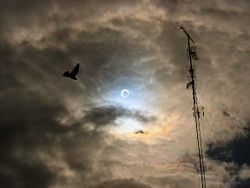
Looking directly at the photosphere of the Sun (the bright disk of the Sun itself), even for just a few seconds, can cause permanent damage to the retina of the eye, because of the intense visible and invisible radiation that the photosphere emits. This damage can result in permanent impairment of vision, up to and including blindness. The retina has no sensitivity to pain, and the effects of retinal damage may not appear for hours, so there is no warning that injury is occurring.[23]
Under normal conditions, the sun is so bright that it is difficult to stare at it directly, so there is no tendency to look at it in a way that might damage the eye. However, during an eclipse, with so much of the Sun covered, it is easier and more tempting to stare at it. Unfortunately, looking at the Sun during an eclipse is just as dangerous as looking at it outside an eclipse, except during the brief period of totality, when the Sun's disk is completely covered (totality occurs only during a total eclipse and only very briefly; it does not occur during a partial or annular eclipse). Viewing the Sun's disk through any kind of optical aid (binoculars, a telescope, or even an optical camera viewfinder) is even more hazardous.[24]
Glancing at the sun with all or most of its disk visible is unlikely to result in permanent harm, as the pupil will close down and reduce the brightness of the whole scene. If the eclipse is near total, the low average amount of light causes the pupil to open. Unfortunately the remaining parts of the sun are still just as bright, so they are now brighter on the retina than when looking at a full Sun. As the eye has a small fovea, for detailed viewing, the tendency will be to track the image on to this best part of the retina, causing damage.
Partial and annular eclipses
Viewing the Sun during partial and annular eclipses (and during total eclipses outside the brief period of totality) requires special eye protection, or indirect viewing methods. The sun's disk can be viewed using appropriate filtration to block the harmful part of the Sun's radiation. Sunglasses are not safe, since they do not block the harmful and invisible infrared radiation which causes retinal damage. Only properly designed and certified solar filters should ever be used for direct viewing of the Sun's disk.
The safest way to view the Sun's disk is by indirect projection. This can be done by projecting an image of the disk onto a white piece of paper or card using a pair of binoculars (with one of the lenses covered), a telescope, or another piece of cardboard with a small hole in it (about 1 mm diameter), often called a pinhole camera. The projected image of the Sun can then be safely viewed; this technique can be used to observe sunspots, as well as eclipses. However, care must be taken to ensure that no one looks through the projector (telescope, pinhole, etc.) directly. Viewing the Sun's disk on a video display screen (provided by a video camera or digital camera) is safe, although the camera itself may be damaged by direct exposure to the Sun. The optical viewfinders provided with some video and digital cameras are not safe.
In the partial eclipse path one will not be able to see the spectacular corona or nearly complete darkening of the sky, yet, depending on how much of the sun's disk is obscured, some darkening may be noticeable. If two-thirds or more of the sun is obscured, then an effect can be observed by which the daylight appears to be dim, as if the sky were overcast, yet objects still cast sharp shadows.
Totality
Contrary to popular belief, it is safe to observe the total phase of a solar eclipse directly with the unaided eye, binoculars, or a telescope, when the Sun's photosphere is completely covered by the Moon; indeed, this is a very spectacular and beautiful sight, and it is too dim to be seen through filters. The Sun's faint corona will be visible, and even the chromosphere, solar prominences, and possibly even a solar flare may be seen. However, it is important to stop directly viewing the Sun promptly at the end of totality. The exact time and duration of totality for the location from which the eclipse is being observed should be determined from a reliable source.
Also very beautiful are the effects just before (and just after) totality. When the shrinking visible part of the photosphere becomes very small, Baily's beads will occur (see picture). These are caused by the sunlight still being able to reach Earth through lunar valleys, but no longer where mountains are present. Totality then begins with the diamond ring effect, the last bright flash of sunlight. Note that it is not entirely safe to view Baily beads or the diamond ring without proper eye protection (because in both cases the photosphere is still visible).
Other observations
For astronomers, a total solar eclipse forms a rare opportunity to observe the corona (the outer layer of the Sun's atmosphere). Normally this is not visible because the photosphere is much brighter than the corona. According to the point reached in the solar cycle, the corona can appear rather small and symmetric, or large and fuzzy. It is very hard to predict this prior to totality.[25]
During a solar eclipse, special (indirect) observations can also be done with the unaided eye only. Normally, the spots of light which fall through the small openings between the leaves of a tree, have a circular shape. These are images of the Sun. During a partial eclipse, the light spots will show the partial shape of the Sun, as seen on the picture. Another famous phenomenon is shadow bands (also known as flying shadows), which are similar to shadows on the bottom of a swimming pool. They only occur just prior to and after totality, and are very difficult to observe. Many professional eclipse chasers have never seen them.[26]
During a partial eclipse, a related effect that can be seen is anisotropy in the shadows of objects. Particularly if the partial eclipse is nearly total, the unobscured part of the sun acts as an approximate line source of light. This means that objects cast shadows which have a very narrow penumbra in one direction, but a broad penumbra in the perpendicular direction.
1919 observations

In 1919, the observation of a total solar eclipse helped to confirm Einstein's theory of general relativity. By comparing the apparent distance between two stars, with and without the Sun between them, Arthur Eddington stated that the theoretical predictions about gravitational lenses were confirmed, though it now appears the data were ambiguous at the time. The observation with the Sun between the stars was only possible during totality, since the stars are then visible.[27]
Before sunrise, after sunset
The phenomenon of atmospheric refraction makes it possible to observe the sun (and hence a solar eclipse) even when it is slightly below the horizon. It is, however, possible for a solar eclipse to attain totality (or in the event of a partial eclipse, near-totality) before (visual and actual) sunrise or after sunset from a particular location. When this occurs shortly before the former or after the latter, the sky will appear much darker than it would otherwise be immediately before sunrise or after sunset. On these occasions, an object (especially a planet, often Mercury) may be visible near the sunrise or sunset point of the horizon when it could not have been seen without the eclipse.
Eclipses and transits
In principle, the simultaneous occurrence of a Solar eclipse and a transit of a planet is possible. But these events are extremely rare because of their short durations. The next anticipated simultaneous occurrence of a Solar eclipse and a transit of Mercury will be on July 5, 6757, and a Solar eclipse and a transit of Venus is expected on April 5, 15232.
Only 5 hours after the transit of Venus on June 4, 1769, there was a total solar eclipse, which was visible in Northern America, Europe and Northern Asia as partial solar eclipse. This was the lowest time difference between a transit of a planet and a solar eclipse in the historical past.
More common, but still quite rare, is a conjunction of any planet (not confined exclusively to Mercury or Venus) at the time of a total solar eclipse, in which event the planet will be visible very near the eclipsed Sun, when without the eclipse it would have been lost in the Sun's glare. At one time, some scientists hypothesized that there may be a planet (often given the name Vulcan) even closer to the Sun than Mercury; the only way to confirm its existence would have been to observe it during a total solar eclipse. However, it is now known that no such planet exists. While there does remain some possibility for small Vulcanoid asteroids to exist, none have ever been found.
Artificial satellites
Artificial satellites can also pass in front of, or transit, the sun as seen from Earth, but none are large enough to cause an eclipse. At the altitude of the International Space Station (ISS), for example, an object would need to be about 3.35 km across to blot the Sun out entirely. These transits are difficult to watch, because the zone of visibility is very small. The satellite passes over the face of the Sun in about a second, typically. As with a transit of a planet, it will not get dark.
Artificial satellites do play an important role in documenting solar eclipses. Images of the umbra on the Earth's surface taken from Mir and the ISS are among the most spectacular eclipse images in history.[28] Observations of eclipses from satellites orbiting above the Earth's atmosphere are of course not subject to weather conditions.
The direct observation of a total solar eclipse from space is rather rare. The only documented case is Gemini 12, in 1966. The partial phase of the 2006 total eclipse was visible from the ISS. At first, it looked as though an orbit correction in the middle of March would bring the ISS in the path of totality, but this correction was postponed.[29]
Notes
- ↑ Solar Eclipses University of Tennessee. Retrieved October 4, 2007.
- ↑ O. Staiger, Solar Eclipses for Beginners Retrieved October 7, 2007.
- ↑ Fred Espenak, Glossary of Solar Eclipse Terms NASA Eclipse Web Site. Retrieved October 10, 2015.
- ↑ R. Hipschman, Why Eclipses Happen The Exploratorium. Retrieved October 18, 2007.
- ↑ Fred Espenak, Fifty Year Canon of Solar Eclipses: 1986–2035 (Greenbelt, MD: NASA RP-1178, 1987).
- ↑ Fred Espenak, World Atlas of Solar Eclipse Paths NASA Eclipse Web Site. Retrieved October 10, 2015.
- ↑ F.R. Stephenson, Historical Eclipses and Earth's Rotation (Cambridge University Press, 1997).
- ↑ Fred Espenak, Eclipses and the Saros NASA Eclipse Web Site. Retrieved October 10, 2015.
- ↑ A. Kendall, The Final Total Eclipse. Retrieved October 25, 2007.
- ↑ Sandra Blakeslee, Ancient Crash, Epic Wave The New York Times, November 14, 2006. Retrieved October 10, 2015.
- ↑ Fred Espenak, Solar Eclipses of Historical Interest NASA Eclipse Web Site. Retrieved October 10, 2015.
- ↑ David Le Conte, Eclipse Quotations. Retrieved October 27, 2007.
- ↑ Herodotus, Book VII, 37.
- ↑ Hind and Chambers, (1889), 323.
- ↑ Herodotus, Book IX, 10.
- ↑ B. E. Schaefer, Solar Eclipses That Changed the World (Sky and Telescope, 1994).
- ↑ C. J. Humphreys and W. G. Waddington, "Dating the Crucifixion," Nature, 306(5945): 743–746.
- ↑ M. Kidger, The Star of Bethlehem: An Astronomer’s View (Princeton, NJ: Princeton University Press, 1999), 68–72.
- ↑ Needham, Volume 3, 411.
- ↑ Needham, Volume 3, 227.
- ↑ Needham, Volume 3, 414.
- ↑ Needham, Volume 3, 415–416.
- ↑ Fred Espenak, Eye Safety During Solar Eclipses. NASA Eclipse Web Site. Retrieved October 10, 2015.
- ↑ A. M. MacRobert, How to Watch a Partial Solar Eclipse Safely. Retrieved October 28, 2007.
- ↑ ESA, The science of eclipses. Retrieved October 30, 2007.
- ↑ D. Dravins, Flying Shadows. Retrieved October 30, 2007.
- ↑ ESA, Relativity and the 1919 eclipse. Retrieved October 30, 2007.
- ↑ Astronomy Picture of the Day, Looking Back on an Eclipsed Earth. Retrieved October 30, 2007.
- ↑ NASA, JSC Digital Image Collection. Retrieved October 30, 2007.
ReferencesISBN links support NWE through referral fees
- Kidger, M. The Star of Bethlehem: An Astronomer’s View. Princeton, NJ: Princeton University Press, 1999.
- NASA. Eclipse Home Page. Retrieved October 10, 2015.
- Needham, Joseph. Science and Civilization in China: Volume 3. Taipei: Caves Books, Ltd, 1986.
- Solar Eclipse Resources. Homepage. Retrieved 2007-10-30.
- Stephenson, F.R. Historical Eclipses and Earth's Rotation. Cambridge University Press, 1997.
External links
All links retrieved February 2, 2023.
- Detailed eclipse explanations and predictions.
- Prof. Druckmüller's eclipse photography site.
- Animated maps of present and past eclipses all over the world.
- UK hospitals assess eye damage after solar eclipse, British Medical Journal, August 21, 1999, p. 319–469.
Credits
New World Encyclopedia writers and editors rewrote and completed the Wikipedia article in accordance with New World Encyclopedia standards. This article abides by terms of the Creative Commons CC-by-sa 3.0 License (CC-by-sa), which may be used and disseminated with proper attribution. Credit is due under the terms of this license that can reference both the New World Encyclopedia contributors and the selfless volunteer contributors of the Wikimedia Foundation. To cite this article click here for a list of acceptable citing formats.The history of earlier contributions by wikipedians is accessible to researchers here:
The history of this article since it was imported to New World Encyclopedia:
Note: Some restrictions may apply to use of individual images which are separately licensed.

